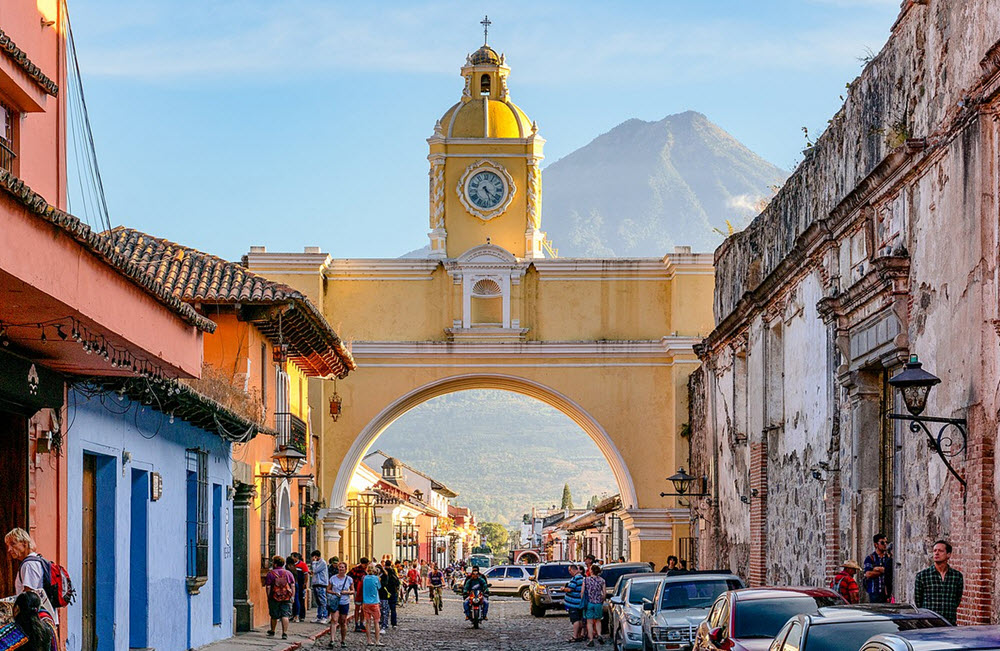Antigua Guatemala, often simply referred to as Antigua, is a picturesque and historically significant city in Guatemala. It has been recognized as a UNESCO World Heritage Site since 1979 and is renowned for its well-preserved Spanish Baroque-influenced architecture as well as a number of ruins of colonial churches, making it a major tourist destination in Guatemala.
Antigua Guatemala offers a unique blend of historical richness, architectural beauty, and vibrant culture, set against the backdrop of stunning natural landscapes. Its preservation as a UNESCO World Heritage Site ensures that future generations can continue to explore and appreciate this captivating city’s past and present. Whether you’re wandering its cobblestone streets, admiring its colonial buildings, or experiencing its lively festivals, Antigua provides a memorable journey into the heart of Guatemala’s cultural heritage.

History
Foundedas “Santiago de los Caballeros de Guatemala,” the city was the capital of the Captaincy General of Guatemala from 1543 through 1773. Back then, it meant it was the capital of most of Central America and southern Mexico.
A series of devastating earthquakes in the 18th century, particularly the Santa Marta earthquakes in 1773, led to the capital’s relocation to a safer location, the newly established Guatemala City.
Antigua Guatemala has retained much of its colonial architecture and charm, largely thanks to restoration efforts and its designation as a national monument by the Guatemalan government in the 1940s.
Architecture and landmarks
Antigua is famous for its colonial architecture, cobbled streets, and vibrant cultural scene. Key landmarks include:
- La iglesia de la Merced: Known for its Baroque architecture and beautiful facade, this church is one of the most photographed in Antigua.
- Arco de Santa Catalina: Perhaps the most iconic structure in Antigua, this arch was originally built to allow nuns to cross the street without being seen. Built in the 1600s, it originally connected different parts of the Santa Catalina convent school with each other. The prominent clock was not added until the 1830s. Arco de Santa Catalina is located on 5th Avenue North.
- Central Park (Parque Central): The heart of Antigua, surrounded by historic buildings, including the Cathedral of San José and the Palace of the Captains General.
- Catedral de San José: The original cathedral was heavily damaged in the 1773 earthquakes, but the ruins and the rebuilt portion offer a glimpse into the city’s grand past.
La Iglesia de la Merced
It is commonly known as la Merced, but its formal name is Iglesia y convento de Nuestra Señora de Las Mercedeswhich means ”Church and Convent of Our Lady of Mercy”.
In 1761, Alonso Fernández de Heredia arrived to the city to become its new captain general. He donated four thousand pesos for the construction of La Merced, and the church was inaguarated in 1767. This was just six years before the great earthquake of 1773 and the church building withstood this quake thans to the new construction techniques that had been employed.
Who are the persons on the churh façade?
- There is a sculpture of St. Peter Nolasco on the façade of the church. He was the founder of the Mercedarian Order.
- The Virgin of Mercy also appears on the façade, together with the Mercedarian shield.
- On the left side of the church, you can see stucco and brick sculptures of San Ramón and San Pedro, who are both Mercedarian saints.
- On the right side of the church are depictions of St. Mary de Cervellione (the first Mercedarian nun) and St. Peter Pascual.
Culture and festivities
Antigua is famous for its vibrant cultural scene and festivities, particularly during Semana Santa (Holy Week). During this week, the city’s streets come alive with processions, elaborate float displays, and colorful alfombras (carpets) made of dyed sawdust, flowers, and fruits. This celebration is among the largest and most renowned in the Western Hemisphere.
Surrounding natural beauty
The natural surroundings offer numerous outdoor activities, including hiking, mountain biking, and coffee plantation tours.
Antigua is nestled between three imposing volcanoes: Agua, Fuego, and Acatenango. Volcán de Fuego is one of Central America’s most active volcanoes, and its eruptions are a sight to behold from a safe distance.
Economy and tourism
Tourism is a significant part of Antigua’s economy, attracting visitors from around the globe drawn to its historical significance, architectural beauty, and cultural festivals. The city is also a hub for language education, with numerous Spanish language schools catering to international students.
Population
In the 1770s, the city reached its peak population size – when roughly 65,000 people lived here. After 1773, when it was no longer a capital city, a lot of people moved out. Despite a significant population growth in the 1900s, the city population only reached a bit above 30,000 in that century. In 2018, the estimated population of Antigua was slightly above 46,000.
Preservation and challenges
While Antigua’s designation as a UNESCO World Heritage Site has helped preserve its colonial architecture and increased its appeal as a tourist destination, the city faces ongoing challenges related to conservation and sustainable tourism. Efforts continue to balance the preservation of its historical sites with the needs of the local population and tourists.